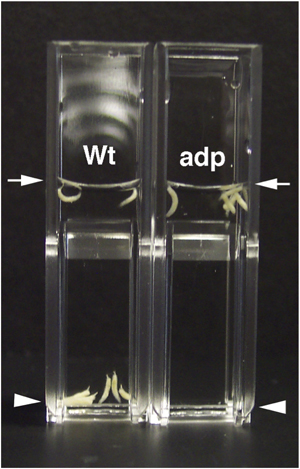
4) Mechanisms that regulate fat storage and energy homeostasis
Different individuals that consume the same diet can vary in their propenisty to accumulate fat implying the existence of genetic factors that regulate weight and fat levels. To understand the regulation of fat storage and energy homeostasis, we are studying the mechanisms that regulate fat storage in Drosophila larvae. Unlike C. elegans, where lipid droplets are stored in intestinal epithelial cells, Drosophila larvae, have a specialized tissue, the fat body, that is used for fat storage. During the larval phase of development, ingested nutients can either be utlized for growth and for generating ATP or stored as fat for use during the pupal phase of development.
We have devised a simple, yet effective, way of identifying genes that regulate the storage of fat in Drosophila larvae. We immerse carefully-staged larvae in a solution of 10% sucrose in which most wild-type larvae sink. Under these conditions, mutant larvae that have increased fat levels tend to float. Using this screening method, we have identified 66 genes, that when mutated, result in increased levels of stored fat. One of these genes was Sir2 which encodes an NAD-dependent protein deacetylase.
 |
The "float-sink" assay: Most wild-type third-instar larvae sink in a solution of 10% sucrose while adipose mutant larvae, which have increased levels of stored fat sink |
We have shown that Sir2 functions to restrict fat accumulation in individual cells of the fat body and that Sir2 mutants display transcriptional changes of genes encoding key metabolic enzymes that are often in the opposite direction to those observed during starvation. Our work has also revealed a role for Sir2 in activating catabolism under conditions of amino-acid starvation even if sugars are provided.
Publication:
Reis T, Van Gilst MR, Hariharan IK (2010) A buoyancy-based screen of Drosophila larvae for fat-storage mutants reveals a role for Sir2 in coupling fat storage to nutrient availability PLoS Genet 6:e1001206 (PubMed) Link to Article in PLoS Genetics (Open Access)
| Home | Research | People | Publications | Contact Us |